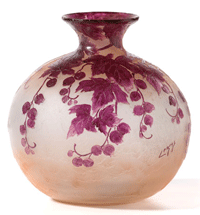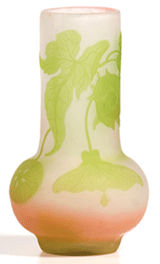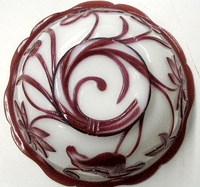|
Cowan's Corner
Cameo Glass Making a Cameo at Auctions
By Wes Cowan
Posted 12/2010
Art glass sprang from a revolution in glassmaking in the mid-1800s, when glass blowers began experimenting with different colors, patterns and textures. The subsequent melding of artistry and technique resulted in a wide variety of beautiful handmade objects. One of these art glass techniques was known as cameo glass, or art glass with small sculpture designs executed in low relief, creating a difficult and time-consuming process.
Cameo glass techniques were first used in the early Roman Era, and the results were nothing less than magnificent. The famous Portland vase, which took ten years to complete, is such a product from this era, and it is believed to have been produced by the hands of a skilled Roman gem-carver around 30 B.C. The vase was made of violet-blue glass and surrounded with a single continuous white glass cameo, depicting Roman and mythological figures. This vase has served as an inspiration to many a glass maker from about the beginning of the 18th century onward.
After the Portland vase was broken while on display in the British Museum, John Northwood, a Stroubridge, England, glass designer and manufacturer was commissioned to replicate the famous vase. It took three years to complete and received rave reviews, which helped establish his notoriety as a fine glass engraver. Northwood started to produce other pieces of cameo glass, for the demand was evident that it was indeed an accepted and desirable form of collectible art. This then began the revival of cameo glass, which was suited equally to Neo-Grec taste and the French Art Nouveau.
Due to the onset popularity of cameo glass in the late 1900s, other English glass manufactures followed Northwood’s revival of glass carving. By 1880-1899, many of the top European glass companies and designers were producing cameo glass. George Woodall, Stevens and Williams, Thomas Webb & Sons, Joseph Locke, Emile Galle, Daum and others were among the list of prestigious glass carvers.
Cameo glass is the result of two or more layers of glass being laminated together by means of acid and hand-tool carving. The final pattern on the outer surface is left in high relief by removing the surrounding area.
The cameo art glass market was well received, and the demands for production by British glass manufacturers continued into the 20th Century. Today, the interest in early cameo glass is still strong among collectors. The knowledge of the skill involved to produce a piece of cameo glass is well appreciated and respected. Daum, Galle, Val St. Lambert, Thomas Webb & Sons, and Woodall are just a few names that are associated with fine cameo art glass and thus bring a very respectable price at auction. In today’s auction market, a five-inch Daum cameo vase would sell for approximately $1,000; an exceptional wheeled, carved cameo vase could sell for $5,000 or more.
Avid collectors who can’t wait to add to their growing collection of cameo glass and even novice collectors can see the beauty and realize what it took to make that glass vase. From the hours designing, the skill in carving, and the finished product, no two cameo glass vases are alike, each being individually created. Cameo glass is an art form from early history that will always and forever be appreciated, as well it should be.
 About the author: Wes Cowan is founder and owner of Cowan’s Auctions, Inc. in Cincinnati, Ohio. An internationally recognized expert in historic Americana, Wes stars in the PBS television series History Detectives and is a featured appraiser on Antiques Roadshow. He can be reached via email at info@cowans.com. Research by Janet Rogers. About the author: Wes Cowan is founder and owner of Cowan’s Auctions, Inc. in Cincinnati, Ohio. An internationally recognized expert in historic Americana, Wes stars in the PBS television series History Detectives and is a featured appraiser on Antiques Roadshow. He can be reached via email at info@cowans.com. Research by Janet Rogers.
|

A Legras cameo art glass vase.

This Galle cameo art glass vase.

This Peking cameo glass bowl sold for $300 in Cowan’s 2005 Furniture and Decorative Arts Auction.
|